Posted in: 11/04/2022

Synergia closely followed the main negotiations of COP27 – the United Nations Conference on Climate Change. And, here on this page , you can check out the analysis of specialists on the main topics of the event, which had daily and exclusive coverage .
The 27th Conference of the Parties of the United Nations (UN) – which this year took place in Sharm el-Sheikh, Egypt, between November 6th and 18th – had the proposal to focus mainly on three challenges: effectively implementing the commitments assumed in the Paris Agreement; to cement the progress achieved at COP26 in Glasgow on the themes of emission mitigation, adaptation, the loss and damage mechanism, increased financing for climate actions and the carbon market (article 6 of the Paris Agreement); and improve transparency in communicating and reviewing country targets in the Paris Agreement.
Our sustainability consultants , José Alberto Gonçalves Pereira and Luiz Eduardo Rielli , who participated in the event in person, brought their opinions and analyzes on COP27 issues, mainly considering relevant topics for Synergia , such as the Amazon, Bioeconomy and Biodiversity, Climate Justice and Social, Nature-Based Solutions, Water Sustainability and Territorial Development.
Held annually, the climate COP is the world’s largest and most important event on climate change. It is at the COP that governments negotiate and approve instruments to accelerate and deepen commitments to cut emissions and adaptation assumed in the Convention on Climate Change and the Paris Agreement. The objective is to prevent the average temperature of planet Earth from rising above 1.5 degrees Celsius by 2100, avoiding the most catastrophic effects of changes in the climate system .
For this edition of the COP, we mainly follow the discussions involving Brazil, both for its bioeconomic potential and for the important role it can play in the process of reducing carbon emissions.
In 2021, Synergia covered the COP26 , which you can also check out to understand a little more about the scenario that is formed for the COP27 actions.
Click Here and sign up to receive our experts’ daily newsletter, straight to your email!
Our sustainability consultant, Luiz Eduardo Rielli, represented Synergia Socioambiental in the program “ESG E TAL” on TV OOPS.
The chat featured Rielli’s perceptions on the COP27 results , the loss and damage mechanism and expectations regarding Brazil’s position for actions against climate change. Check out the video!
Political obstacles cannot be considered a plausible justification for the private sector to remain silent when it comes to climate justice .
And to discuss the topic, José Alberto Gonçalves Pereira , our climate change consultant, interviewed Ricardo Young – chairman of the board of directors of the Instituto Democracia e Sustentabilidade (IDS), former president of the Ethos Institute and member of the Council of Synergia Socioambiental – about his assessment regarding the importance of the climate justice agenda .
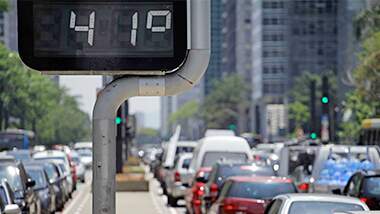
In the interview, Ricardo answers about the responsibility of companies in relation to their impacts on society, the role of issuing countries as responsible for the losses and damages of the most vulnerable countries and about the difficulty of reaching a global consensus on the commitment to actions to curb the increase in the average temperature of the planet of 1.5ºC, in relation to pre-industrial levels.
Check out the full interview at: “COP27 signals the importance of climate justice for the market, says Ricardo Young”
By Luiz Eduardo Rielli
COP27 ended on Sunday , November 20th, two days after its formal closing . That, in itself, is already a novelty for this edition, as COPs usually end on Saturday. However, there was a commitment for the negotiators to remain in Egypt until the conclusion of the negotiations.
Today, we are going to take stock of the meeting , which was expected to be the moment of implementation . That is, it was not a meeting to present big commitments or new ambitions – not least because, in Glasglow, a series of commitments had already been assumed.
The big news was, in fact, the inclusion of the topic of “losses and damages” in the official agenda. This was a demand from developing countries for more than 30 years , and it was a central theme in the debates. Yesterday, finally, a conclusion was reached on the creation of an international fund to support countries with less capacity in responding to the effects and impacts of climate change.
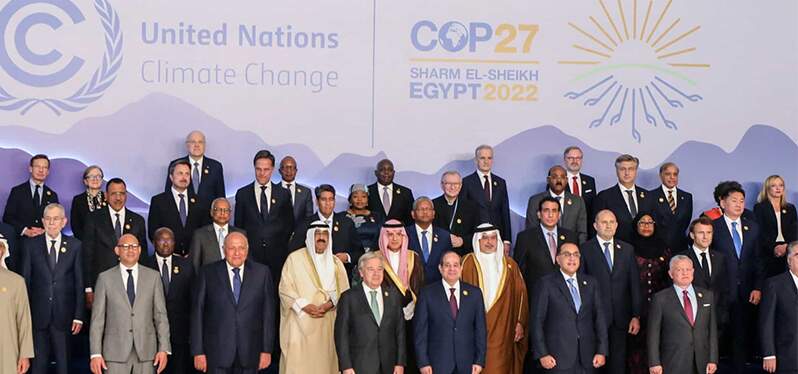
There are still many doubts about how this will work, the main ones being about who will provide resources and who will be able to use the resources of this fund, what is the governance and who makes the decisions . These are all fundamental issues surrounding the creation of the damages fund.
The European Union leaves the negotiations quite disappointed , according to the European negotiator. For the United States , there was a relative advance , considering that the country has always been against the creation of any loss and damage mechanism. The developing countries, represented by the G77+China , considered it a step forward – despite not being enough .
In a more general context, the scientific limit of an average temperature increase of 1.5°C was maintained until the end of the century as the safe limit . There have been no setbacks in this regard, but neither have we had new advances.
The war in Ukraine was the starting point for COP27. In the end, the theme used in Glasglow, of “ phase down ” and the use of fossil fuels , mainly coal, was replaced by a softer term: looking for “ low emission energies ” or lower emission fuels. This paves the way for countries to return to investing in natural gas and even mineral coal . Remembering that winter in Europe is now starting and many countries will need to reactivate their thermoelectric plants powered by fossil fuels in order to guarantee the energy security of their populations.
On the subject of the carbon market , which also arouses our interest, article 6 of the Paris Agreement advanced in technical terms and in themes such as carbon registration, reporting and tracking – more technical factors, but which were essential to give life to the international market. In addition, we had the announcement made by Switzerland and Ghana about the first international agreement between countries , article 6.2, about the carbon exchange foreseen in this new market between countries.
Finally, Brazil was new at the COP , in political terms. The presence of the president-elect, Luís Inácio Lula da Silva, bringing the agenda to combat deforestation – zero deforestation – and, with that, the reactivation of the Amazon Fund by Germany and Norway. In addition, we also had a formal invitation made to the United States for the country to join the Amazon Fund – and its declaration that there are already studies for this purpose. All this generated great interest in the position of the new Brazilian government.
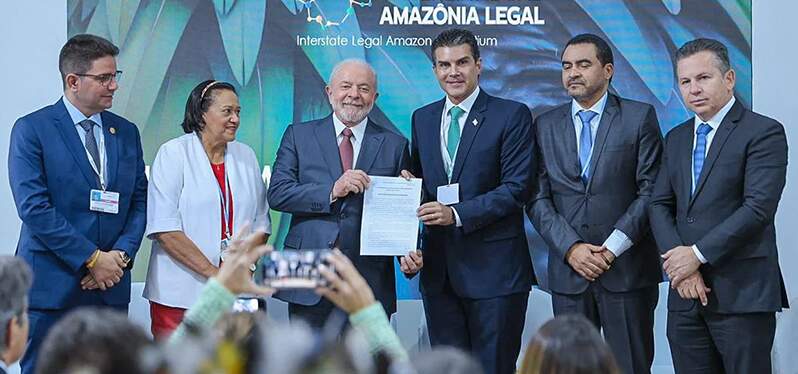
Brazil participated in this COP with a large delegation of representatives of civil society and the private sector , between 600 and 700 people. I believe that we are now beginning a new political cycle , with the merging of the theme of combating poverty and the theme of climate change. Lula brought up the theme of climate justice and there will be a lot of interest, both from civil society and the private sector, in supporting the implementation of these initiatives in which Brazil can indeed be a champion.
The final message is that Brazil is a great environmental, forestry and water power . And the country is a major supplier and partner of two issues on the international agenda that are prominent in today’s world: energy security and food security .
Thus, we ended our participation in the daily coverage of COP27. But we will still return to the theme throughout the week. In addition, Synergia continues to plan initiatives , operating in the Amazon territory and being a partner company for the implementation of these new agendas that have emerged.
The loss and damage mechanism and compensation have been some of the main themes of COP27 . But the practice of greenwashing also gained attention, most notably with the release of the report with recommendations to improve the integrity and transparency of commitments to zero net emissions of greenhouse gases by 2050 .

With its recommendations, the report can contribute to the definition of tougher rules in the fight against greenwashing and reduce the presentation of misleading or exaggerated information about the positive environmental impacts of a product, service or activity.
Learn more about greenwashing (green makeup) and topics such as the Green Taxonomy ( green taxonomy) and the Green Silence (green-hushing) in the article produced by José Alberto Gonçalves Pereira , our consultant for climate change.
Check it out: UN and regulators in the fight against greenwashing
By Luiz Eduardo Rielli
Today’s highlight goes, once again, to the main topic of this COP: negotiation . After all, this should have been the subject that brought so many people to this year’s conference in Egypt. And the big theme of the negotiation is “ loss and damage ” , which was the big news on the agenda .
Returning a little to the explanation of “losses and damages”, we remind you that it is a financial mechanism to offer resources to countries that are already suffering the impacts of climate change , especially less developed countries and islands.
It is worth noting that all climate prevention and precaution projects are related to the loss and damage mechanism , training, installation of sirens, physical protection structures, monitoring of climate issues and support in extreme events, recovery and emergency actions.
Today, there are two large groups that are trying to reach an agreement: the group of developed countries , led by the European Union and the United States , and another group called G77+China , formed by developing countries . Despite the name, the group is made up of around 130 countries , forming a political coalition to negotiate issues. On Wednesday (11/16), the G77 presented a first draft of the text, promptly criticized by the rich countries.
Europe , for its part, shows that it is aware, concerned and willing to contribute financial resources for damages. We even had a recent announcement about the unilateral support of the European Union (EU).
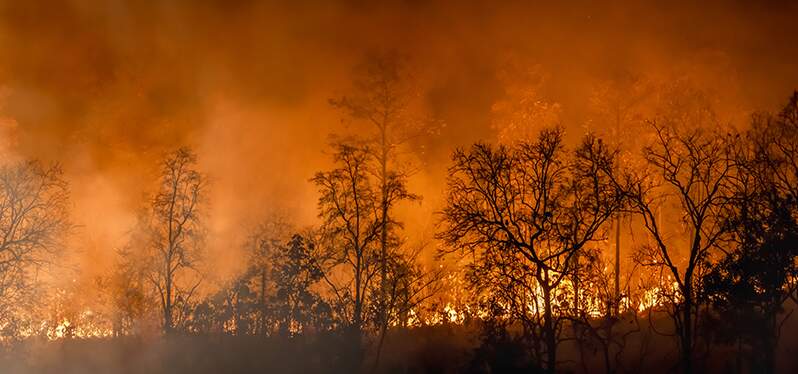
It is also important to say that there is already a series of resources that have been promised, in the order of US$300 billion to be allocated directly to the countries and in some specific networks. However, what is sought at the international conference is a global governance mechanism for losses and damages , multilateral and that participates in the governance of developing countries, which defines where the resource will be allocated and with what priority.
The United States does not accept any form of binding compensation or liability agreements . That is, that they have to pay for something that is happening in a poor country. The country is also very concerned about defending the limits and scope of this type of resource.
Other countries, such as New Zealand and Japan , are trying to slow down this negotiation, as it has been predicted since Glasgow that this mechanism would be put into practice from 2024 onwards . Some countries want to postpone this debate.
The European Union has three points of disagreement with the draft presented by the G77+China. The first is his disagreement that the basis of the conversation is its initial moment, in 1992, 30 years ago. The EU understands that several countries have changed their economies over the past 30 years and have the potential to contribute as well, not just receive resources. In this case, the EU is basically pointing to the situation of China , as it believes that the country cannot claim resources when it presents an economy that, in fact, should contribute to smaller countries.
Thus, the European Union believes that it is necessary to institute a system in which everyone contributes on the basis of 2022. This is a point of disagreement with developing countries, including Brazil .
The second point is where the fund’s resources will be allocated, where the money will be allocated . In the G77 proposal, all developing countries would have potential, while the EU believes that the funds should be allocated to countries that suffer the most impact , are most vulnerable and have little capacity to respond.
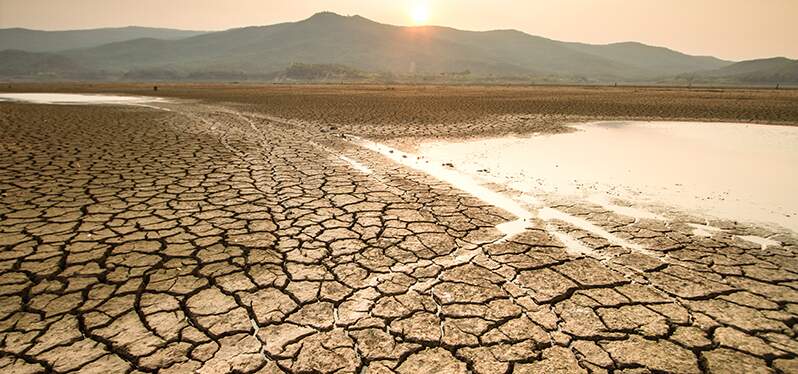
The third point is the “ facility ”, a financial instrument to create this fund. Every G77 proposal is based on the creation of the fund , and the European Union does not agree with that, as it believes that it will take a long time for the fund, governance and rules to be structured, while the money needs to be released as soon as possible.
In this way, the European Union proposes to start financing now , with the creation of a horizon structure and negotiation of time until COP29 , for example, and the other elements to be structured in parallel .
China and Brazil are afraid of this path, for creating an investment now, with certain rules , priorities and criteria , without it becoming institutionalized. That is, that it does not become, in fact, a large global fund for damages.
Finally, there is always criticism from developing countries that the resources promised 30 years ago are no longer sufficient . The European Union counters with the idea that they will never be enough, and points, using a proposal from the Maldives, to the need to create a large mosaic of financial instruments in the world for the climate issue, with a portion of it dedicated to the issue of losses and damages.
The theme has not yet been exhausted, and the discussions should last until tomorrow (Saturday, 11/19).
A just climate transition requires the adoption of socio-environmental justice safeguards, principles and guidelines in the execution of projects, both by investors and companies.
In regions inhabited by low-income populations and areas relevant to the conservation of biodiversity and the balance of the climate system , including territories of indigenous peoples , traditional peoples and territories occupied by small producers and agrarian reform settlers , following these principles is essential.
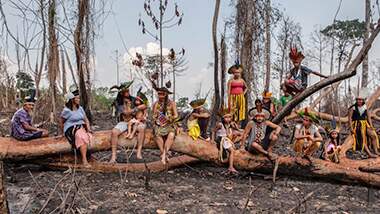
To learn more about the topic , and understand the importance of considering the knowledge and rights of these peoples for the climate transition, check out the article “Safeguards for a fair climate transition” , produced by Maria Albuquerque, founder and CEO of Synergia Socioambiental, and José Alberto Gonçalves Pereira, our sustainability consultant.
By José Alberto Gonçalves Pereira
Confusing draft of ‘final statement’
A rare consensus was reached this Thursday, 17th, in Sharm el-Sheikh, between diplomats from rich and poor countries, NGO observers and activists – that the Egyptian presidency of COP27 promoted chaos in the negotiations by presenting what supposed to be a 20-page draft of the cover decision .
The confusing text left out important demands raised by some countries and included passages that angered diplomats from other nations. Adopted at the close of climate summits , the cover decision is a political declaration that presents the objectives and commitments agreed by consensus between all parties to the negotiation. However, the president of COP27, Sameh Shoukry, Minister of Foreign Affairs of Egypt, clarified that the draft was only a collection of ideas , which only fed back the insecurity of the delegates regarding the final declaration.
The Egyptian presidency of COP27 had already expressed that it did not expect an ambitious cover decision, betting on a text that reinforced the implementation of existing agreements. However, very little progress has been made until today, the eve of the last official day of the event (which should probably last until Saturday).
Fossil fuels
The draft cover decision lacks any references to reducing the use of all fossil fuels , as proposed by India, supported by the European Union, United Kingdom and United States. It is also expected that there will be progress on this topic in relation to COP26, which took place in Glasgow in November 2021.
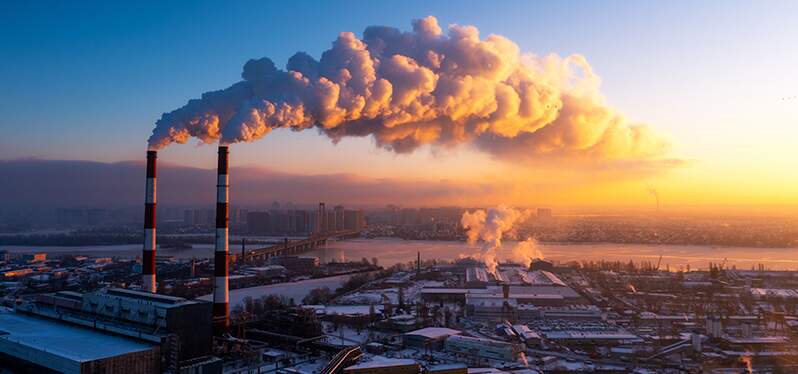
At that meeting, significant progress was made regarding the gradual decrease in the use of energy from coal whose emissions are not offset by carbon sequestration by technologies such as CO2 capture and storage.
Standoff over loss and damage continues
There is also no mention, in the draft presented today by the COP27 presidency, of a damages mechanism emphatically advocated by developing nations to financially repair countries affected by extreme weather events. The gap caused revolt among representatives of countries that are already suffering huge losses resulting, for example, from floods generated by the melting of glaciers, as in the Himalayan region, in Asia.
Representative of the G77 in the negotiations on the mechanism of loss and damage, Sherry Rehman, Minister of Climate Change of Pakistan, defended today at the climate summit held in Sharm el-Sheikh “a bargain between the Global North and the Global South” to establish a fund that funnels billions of dollars to poor countries, which bear the brunt of the impacts of climate change.
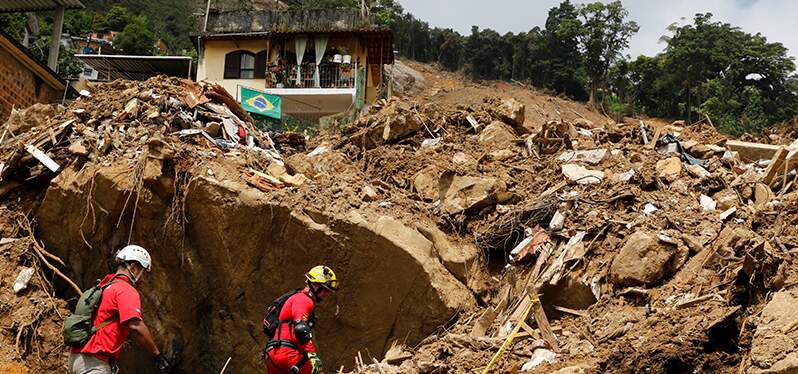
“Climate justice delayed is climate justice denied,” he said, recalling the recent flood that covered a third of Pakistani territory, affecting 33 million people . “Vulnerability should not become a death sentence. This is what many economies and countries and people are facing,” said Rehman.
After an initial victory, with the formal inclusion of the issue on the COP27 agenda, negotiations on loss and damage did not move forward, despite the proposal for a new financial mechanism, presented yesterday by developing countries. Some donor countries, such as France and the United States , remain opposed to such a mechanism, preferring to support the Global Shield Against Climate Change, which will provide insurance to be activated quickly to mitigate the effects of disasters outside the UN process.
Agreement on only two items
Only two of the 31 items on the COP27 agenda had been agreed upon by late afternoon today. One of the items deals with the Santiago Network , created at COP25 within the Warsaw International Mechanism , in December 2019, in Madrid, to catalyze technical assistance aimed at preventing and minimizing losses and damages caused by climate events in the most vulnerable developing countries.
The second item that has already been negotiated is that of the Koronivia Working Group , created at COP23, held in 2018 in Bonn, to study adaptation and resilience actions in agriculture , aimed at food production with sustainability.
Guterres Alert
Newly arrived from Bali, where he followed the G20 meeting , the UN secretary general, António Guterres, warned today that time is running out for the negotiations in Sharm el-Sheikh and for the planet. “The climate clock is ticking and confidence continues to decline,” said Guterres.
“There is clearly a collapse in confidence in the north and south and between developed and emerging economies,” warned the UN secretary general, who urged countries to continue trying to reach an agreement . “This is not the time to point fingers. The blame game is a recipe for mutually assured destruction.”
Lula meets indigenous leaders
The president-elect of Brazil, Luiz Inácio Lula da Silva, met today at the convention center where the COP27 is being held with indigenous leaders from seven regions of the planet – Africa, Asia, Russia and Eastern Europe, Arctic, North America and America Latin. A representative from each region spoke to Lula for one minute each. In general, they placed enormous hope in the Brazilian leader , seen as a politician who values the knowledge of traditional peoples and understands their role in tackling climate change and conserving nature.
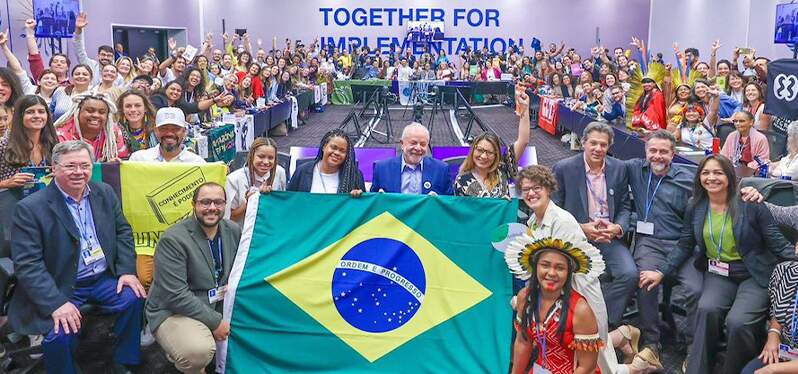
Lula said that those most impacted by the climate emergency are not represented at the COP27 negotiations and said that he has the feeling that nothing was said about civil society at the last G20 meeting, held this week in Indonesia. “Poor people are not on the agenda, they are not on their agenda… indigenous communities, black communities… unions,” he said.
By Luiz Eduardo Rielli
The presence of the president-elect, Luís Inácio Lula da Silva , was today’s main milestone at COP27. His speech was relevant in the sense of public policies and the formation of a future vision of the country , in addition to bringing implications for projects in the Amazon , an extremely important topic for Synergia.
In the morning, Lula was invited to participate by the Amazon Consortium panel , led by the governor of Pará, Hélder Barbalho , who delivered some proposals for the region to the future president . The event was held in a very small space, even leaving the authorities out and causing some turmoil even in the other pavilions.
The main points were the fact that this was Lula’s first appearance at a COP event , where he highlighted the theme of the Amazon , and the fact that the speech was given in the space of the delegations, interacting directly with civil society .
The other event with Lula’s participation, held in the afternoon, also had maximum capacity , being shown in online transmission to other rooms. Not only did Brazilian people at the venue seek to attend the speech, but people and authorities from several other countries were interested in listening to Lula’s position on the topics covered and, above all, on Brazil’s stance on climate issues in its future government. .
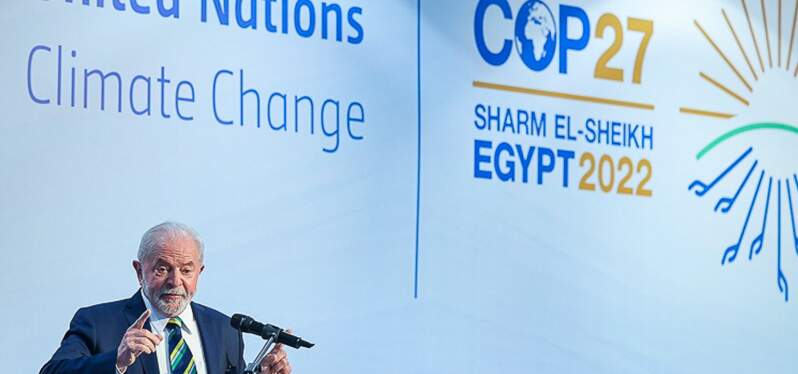
The first international speech as president-elect was marked by speeches that went far beyond the climate issue , including the theme of how Brazil will insert itself in the international scenario from now on.
The starting point raised was about Brazil’s return to a multilateralist stance , seeking to build new international institutions , new governance , reform of the UN Security Council and the need to include emerging countries – which today are very relevant not only for climate issues, but for all international issues.
In the second point addressed, Lula brought up the idea that the issues of poverty and climate justice need to go hand in hand , and they will be two very strong agendas in Brazil. He pointed to the fact that the country needs to position itself as a forest and water power , and that, despite having an abundance of resources, no one is safe. Even Brazil, with many resources, will suffer the effects of climate . Therefore, all countries need to act quickly .
Lula highlighted that the fight against global warming is also the fight against poverty , because poor people will be the ones who will suffer the most impacts. The fact deserves to be highlighted since the president-elect associates, from the outset, the issue of poverty with the issue of climate justice.
In terms of news, Lula reinforced that the climate issue will be at the highest hierarchical and political level in the structure of his government . However, he did not make any specific announcements. He declared that he will recompose all the bodies linked to preservation , command, control and everything else that is necessary to contain deforestation . In addition, he reinforced Brazil’s commitment to have zero deforestation by 2030 and to create a Ministry of indigenous peoples , which can give voice to these peoples.
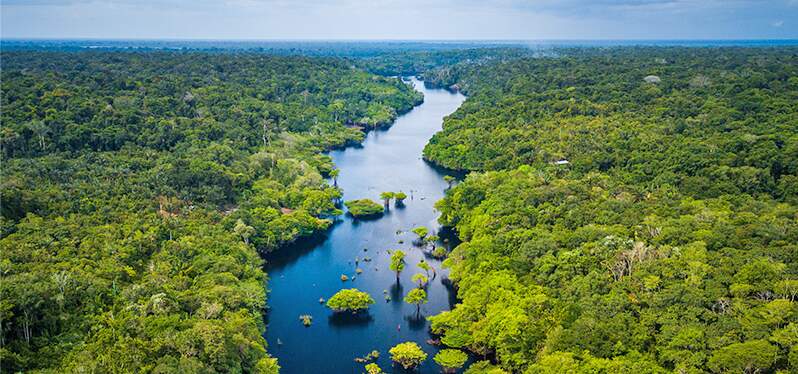
Another point that drew attention was his indication that there are already conversations with Norway and Germany to unlock the Amazon Fund , in addition to conversations with other countries to increase the level of financing . Lula pointed out that Brazil needs to have international financing to facilitate investments in preservation actions, maintaining the posture of closing partnerships, without renouncing sovereignty and national interests.
The president-elect also signaled to industry , to the renewable energy sector and to agriculture about the fact that agribusiness is a partner of this vision, and that there is no contradiction in that. He also indicated that he intends to convene a summit of Amazonian countries to be held next year, in addition to pleading for the Amazon to host the COP30 , in 2025.
Analyzing his speech, it is possible to understand that it was much more an opening of Lula’s third government to the international community , where he positioned himself as a statesman, in addition to pointing out that it is Brazil’s role to be in the front seats, in control of the facts that happen in the world, and that your position will be to lead, call and demand.
In addition to associating climate and poverty quite clearly, Lula points to macro issues, such as trade and multilateralism, and to the desire for a proactive stance in relation to them.
Although it was more the definition of a great international agenda than the presentation of plans, initiatives or actions, the speech was well received . There haven’t been any big announcements or big news. However, Lula reinforced a series of elements that she had been indicating during her campaign and in the two weeks after winning the elections. The speech was positive and quite celebrated around here.
Climate justice gained prominence in the negotiations held at COP27 , mainly in debates on financing adaptation for developing countries to face the impacts of climate change and the mechanism to compensate poor nations for losses and damages resulting from extreme events.
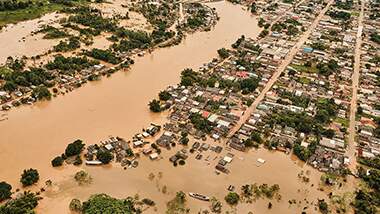
To understand more about the topic – which has also been gaining ground outside the specific debates of environmentalists, mainly in the business world – check out the article “The ethical dilemma of climate justice” .
Produced by Maria Albuquerque , founder and CEO of Synergia Socioambiental, and José Alberto Gonçalves Pereira , our sustainability consultant, the article addresses the current scenario and expectations for dealing with issues related to climate justice
By Luiz Eduardo Rielli
Today our coverage is dedicated to the main subject of this COP27, the theme of “losses and damages” . Let’s start by remembering what this theme is.
“Loss and damage” is the technical name given to the demand to create a financial mechanism to compensate developing countries , mainly insular countries (islands), for the great losses they will suffer from the impacts of climate change. This is a historic demand from the countries of the global south, from developing countries, such as the African group, and from island countries. In 30 years , the issue has never been placed on the agenda, and the novelty of the COP in Egypt is that, finally, it was included on the agenda and on the negotiating agenda .
One of today’s meetings focused on creating a status to try to understand how the issue is going, as the technical debate made little headway . Therefore, a last-minute meeting was called to try to bring a new political vision to the matter.
In Glasglow last year it was indicated that ‘damage and damage’ should be on the agenda. In fact, Egypt managed to put the topic on the agenda and has already indicated that it will only be concluded in 2024 . The country’s view is that it will not be at this COP that we will have clarity on what the “loss and damage” mechanism is. But Egypt’s own expectation is that there will be a good understanding of what this financial mechanism is , what is the path that should be followed and what are the main assumptions in relation to this mechanism. That is, there is no expectation of conclusion , but of having clarity on how the mechanism will occur.
Overall, the positive point is that the topic has entered the agenda and is being discussed daily. No one questioned why the mechanism was made and why it was needed. However, neither the “what” nor the “how” are close to being well defined.
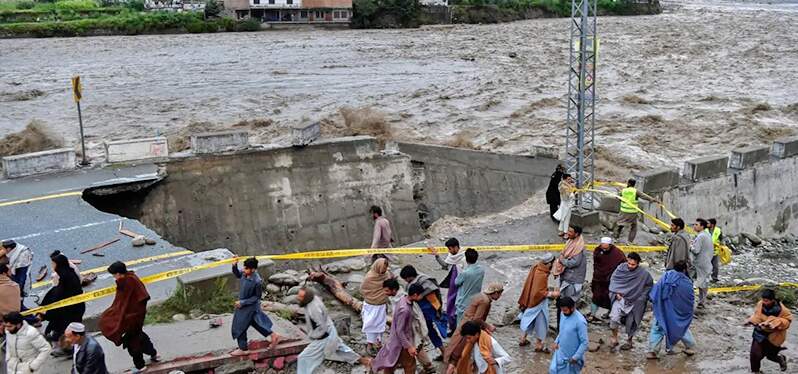
Today, in the plenary, some countries asked for the floor and summarized well. On the side of rich countries, New Zealand , for example, understands that the mechanism is necessary , but that it is not yet clear what the limits , borders and scope will be . In addition, the country raised questions about what financial mechanism would be used , whether a new agency would be created or whether it would be done by an existing bank ; whether it will be linked to the debts of the poorest countries or whether it will be something completely outside the debt levelof the countries. New Zealand brought a series of “buts” and constraints for the “loss and damage” mechanism to advance.
Another interesting point is that, shortly afterwards, the diplomat from the Dominican Republic asked for the floor and pointed out that, in fact, this is a demand from 30 years ago and the impacts are already occurring. That is, it is not something for the future , as we already have real losses . Therefore, it is necessary to be very clear, from now on, on how to compensate these countries.
Lastly, the Pakistani diplomat also pointed out the need for clarity on how it will be done and what the volume of investment would be , as it is a matter of survival for that country, and not a matter of wishes or desires. Countries are already suffering and will suffer more and more, with more intensity . We have already pointed out the case of Pakistan, which has had major floods this year.
Brazil is little involved in this matter. Although it supports less developed countries, it is not a theme that the country is leading, being much more interested in financing projects that prevent deforestation and reduce emissions .
Specifically on the subject of “losses and damages”, what can be seen is that we are in a moment of technical negotiations , but that there is no expectation of a stronger announcement during this COP. This can generate a lot of frustration , as the people who came to the conference are waiting for solutions , especially when we consider that, once again, science is pointing out the problems of global warming and its impacts. In addition, there is the issue of the trajectory of the planet in relation to greenhouse gas emissions , which is a trajectory of great losses and many impacts. That is, we would already need to be talking about adaptationand solutions .
By José Alberto Gonçalves Pereira
Warning about the 1.5°C target
The British Alok Sharma, president of COP 26, today made an emphatic defense of the Glasgow climate pact , which commits the world to preventing the average temperature of the planet from rising above 1.5ºC . “This could be the COP where we leave [the goal of] 1.5ºC behind”, warned Sharma at the high-level ministerial round table held by the COP27 presidency.
The event aimed to increase the engagement of high-level authorities in increasing the ambition of pre-2030 mitigation targets. According to a report published last October by the UN, global greenhouse gas emissions will rise by 10.6% by 2030 compared to 2010 levels if the signatory countries of the Paris Agreement meet the commitments made in their Contributions Nationally Determined (NDCs) .
“At COP26, we collectively decided to pursue efforts to limit the increase in temperature to 1.5ºC. I have always stated that what we agreed on in Glasgow and Paris must be the baseline of our ambition. We have to keep that commitment. We cannot allow any backsliding,” Sharma told the ministers, who arrived in Sharm el-Shekh to guide their countries’ negotiators and make decisions on sensitive issues such as climate finance .
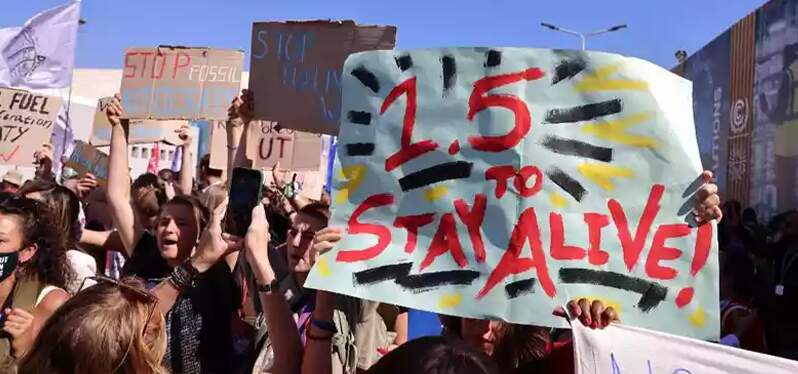
Sharma urged countries to clearly state how they will cut emissions in line with the 1.5°C target . He also said that the leaders of the G20 (group of the 20 largest economies) meeting on the island of Bali, in Indonesia, need to reaffirm the commitments assumed in Paris and Glasgow.
Second week
The second week of negotiations at COP 27 began this Monday with 13 issues to be agreed upon. Financing, mitigation, adaptation and loss and damage are the topics that are most absorbing the attention of negotiators. The ministers began their participation in the negotiations today, being requested by the officials of their portfolios, especially in the conversations on financing and mitigation , politically more sensitive areas.
COP in Brazil in 2025
While the arrival of the president-elect, Luiz Inácio Lula da Silva, is eagerly awaited at COP27, former Environment Minister Marina Silva said that Brazil would love to host the climate COP in 2025 . Lula left São Paulo earlier today for Sharm el-Sheikh, where the UN climate summit is taking place.
Insurance scheme for damages
Developing countries criticized the G7 (group of seven richest countries) strategy for the loss and damage mechanism, which was officially included in the agenda of the COP27 negotiators. Wealthier nations are proposing an insurance scheme called the “ Global Shield ” as an alternative to a loss and damages fund, as defended by developing countries.
forestry alliance
It was announced at the G20 meeting in Bali, this Monday morning, the Alliance of Forests between Brazil, Congo and Indonesia. The trilateral agreement provides for cooperation on the conservation agenda , sustainable management of tropical forests and the bioeconomy , including the negotiation of a new financing mechanism in the Biodiversity Convention. The theme of forests has also become one of the most relevant in climate COPs, considering the enormous potential for removing and maintaining carbon stocks in regions rich in tropical forests. The agreement between the three countries began to be conceived at COP26, in Glasgow.
By Luiz Eduardo Rielli
The Global Compact event at COP27, covered today by Synergia, presented the theme “ Business Climate Action ”, and discussed the search for effective actions that the private sector has taken in this context of implementing commitments . Several topics were addressed, from aspects of science , through the decarbonization of industry, agriculture , the Amazon rainforest , the theme of water , financing and climate justice , among others. And we can highlight some points.
An interesting topic that was reinforced is that, in relation to the companies’ commitments and decarbonization targets , there is now, in fact, the understanding that the Science Based Targets Initiative (SBTi) platform is the official decarbonization platform , the platform that companies must adhere to in order to seek goals that are in fact adherent to science and that make real contributions .
The SBTi presents a series of sectoral protocols , showing how each sector must establish its goals. In this sense, even the UN secretary general, António Guterres, recommended that companies join the SBTi .
In a speech at the Global Compact event, Gonçalo Munhoz – champion of Climate Change, representative of the UN secretary general – pointed out that, in 2019, when companies started to adhere to a zero target by 2050 , called Race to Zero , they were few companies, around dozens , managed to join. Today, there are 12,000 companies that have already gone through the process and have decarbonization targets according to science. Brazil followed an increasing path to reach the goal by 2050.
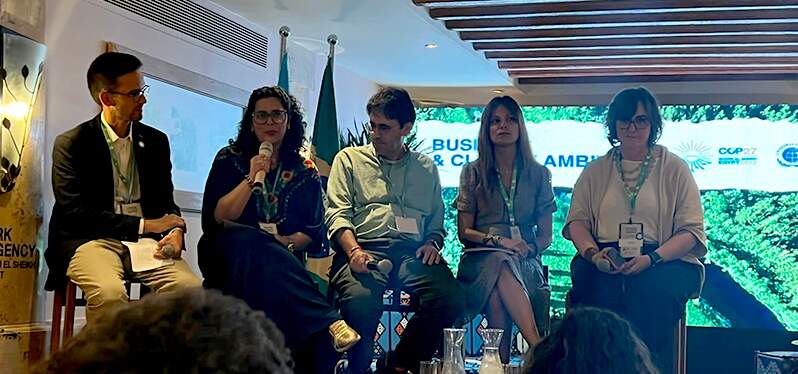
In addition to SBTi and the theme of sustainable finance, two speeches by Gonçalo Munhoz and the president of the National Bank for Economic and Social Development (BNDES), Gustavo Montezano, pointed out that finance will be sustainable by itself, because climate change is a vector of risk for those who make investments. It is a real risk factor that needs to be well understood , measured and monitored . This will become part of the BNDES’ day-to-day logic, as the bank is making a monumental training effort, with almost 600 executives undergoing training to be able to understand the changes and adaptations.
There is a very interesting commitment that for every investment made by the bank, an analysis of the carbon footprint of the investment’s life cycle will have to be carried out . That is, from the outset, before granting the financing, it will be known what the type of footprint will be.
Montezano pointed out that money to carry out decarbonization in the world, in fact, already exists , and the BNDES has its own decarbonization lines. What is lacking, in his view, are well-structured projects that are effective and with environmental integrity; public policies and governance that guarantee permanence and social participation, which are policies, in fact, that encourage decarbonization; knowledge : intellectual capital both in companies and in the bank, it is necessary to share knowledge; and, finally, financial capital , which in his view is not the biggest problem.
The exhibition in which I participated in the Global Compact panel , presenting Synergia and following these 4 points indicated by Montezano, was important to show how Synergia contributes to each of these topics , with projects, policies, the institutional part and the sharing of knowledge .
In the panel, the most important message was that it is indeed necessary to have cooperation and involve more actors for projects in the Amazon . In addition, there is the issue of understanding people in local communities as a key part of the solution rather than the problem.
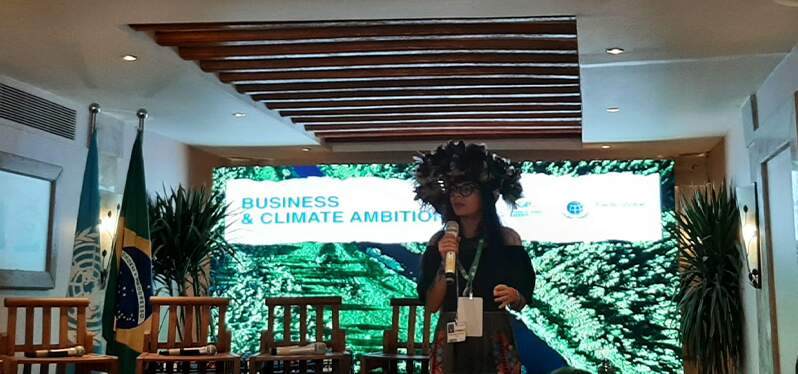
Brazil, obviously, has many fronts , capacities and competences to be a vanguard country, a champion of this low carbon economy in the 21st century. But we need to have more technical and scientific rigor to measure, verify and monitor to guarantee that, in fact , the implementations are low carbon and are reducing emissions. In addition, to provide legal and institutional security for those who want to invest, who want to capture this type of benefit.
Brazil is a low carbon champion and has everything to be in a good position. But this needs to be better structured so that it can be understood by everyone, both governments and international companies . We still need to structure ourselves and position ourselves better as a country.
By Luiz Eduardo Rielli
Today the highlight of the day was about industry and the decarbonization of the productive sector . We participated in an event in the cement sector and, shortly afterwards, in an event in the steel sector . Both are large emitters of greenhouse gases, considered “ hard-to-slaughter sectors ” – sectors in which cutting emissions is more complex, especially with regard to the costs and technologies needed to replace carbon-intensive inputs. . In this case, we are talking about cement, steel, glass, ceramics, chemicals, fertilizers and all those that are intensive in emissions, mainly in industrial emissions.
That is, in the material’s production process itself , there is a large amount of greenhouse gas emissions. This is not only associated with the use of energy, but it is the industrial and chemical process itself that releases carbon . In the cement and steel sectors, the decarbonization of their inputs generates large emissions.
The cement sector is far behind in terms of creating decarbonization plans . There are global and national initiatives, but the important thing is to understand whether the actions have already started to be effectively implemented in this decade of action .
The CEOs of the largest global cement companies participated in this meeting, and everyone pointed out the need to decarbonize the sector , a fact that needs to be viable and effective.
The cement sector already has a series of actions underway. But the big message from all the CEOs was that, for some issues with higher risk, it will always be necessary to form pre-competitive coalitions and groups to try to unlock the technologies and the government money that can help in what is really very difficult to be done. done alone by the private sector , mainly in emerging technologies, such as carbon capture – the “carbon capture storage and usage (CCSU)”, which was considered essential for the carbon sector to reach net zero emissions by 2050 , a general goal to reach.
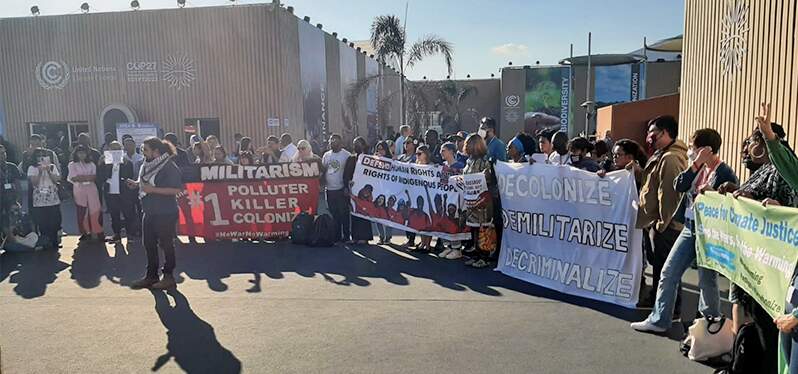
About the events that took place in the afternoon, we highlight the speech of the American president Joe Biden , who was in the plenary and presented a little of the vision of the United States , the commitments that are proposed and the type of leadership that the country will exercise.
It was a somewhat modest speech . There were no major announcements, news or counterpoints. It also reflects some of the context of international geopolitics in the positions of Russia, the war, China and so on.
The novelty was the fact that the US Federal Government adopted an internal policy for all suppliers to submit reports, indicators and targets linked to the reduction of emissions and aligned with the Paris agreement . It is the power of the public machine and the American public purchase for the American productive sector to advance.
Biden also said that in the area of international cooperation there is an estimate to allocate up to US$ 11 billion per year until 2030 . This year, US$ 2 billion has already been approved for mitigation issues , but mainly adaptation – such as warnings and precautions for climate issues.
It is also important to point out that in a previous lecture, the person in charge of the North American Agency for International Development (USAID) also indicated that countries in the Amazon arc, such as Brazil, will benefit from more resources, but still a little modest in relation to to other countries in Europe .
It seems that the United States has not yet found the way to make large investments in international cooperation.
By José Alberto Gonçalves Pereira
President Joe Biden’s speech
The great attraction of COP27 this Friday (11) was the strong presence of the US government at the International Convention Center in Sharm el-Shekh, where the UN climate summit takes place. In addition to the highly anticipated speech by President Joe Biden, COP27 was attended by the US Presidential Special Envoy for Climate, John Kerry , who was seen throughout the day at the venue, and the Speaker of the House of Representatives, Nancy Pelosi , who made a surprise appearance. , accompanied by other members of Congress.
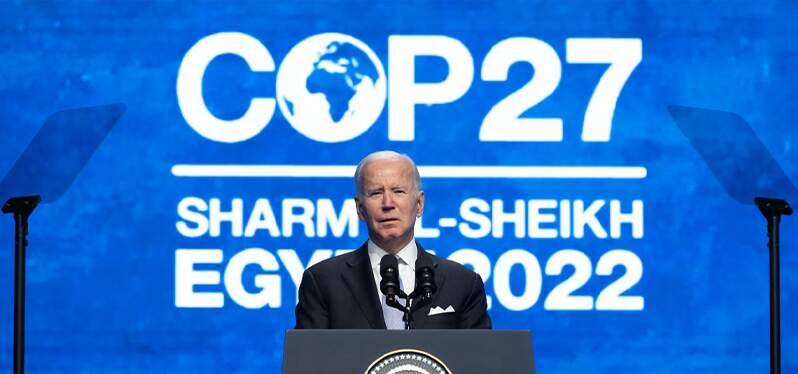
President Joe Biden delivered a speech highlighting his administration’s commitment to an advanced climate agenda . In the speech, Biden announced a series of measures , including a plan to reduce methane emissions in the US , support for new early warning systems for extreme weather disasters in Africa and an agreement to support new solar and wind energy projects in Egypt in compensation for the deactivation of gas plants in the country and cut in emissions.
His speech was briefly interrupted by youth and Native American activists, who urged him to no longer expand fossil fuel extraction.
Brazil out of announcement on decarbonization
On Decarbonization Day at COP27, Brazil was left out of a group of countries that announced 25 new collaborative actions to decarbonize their economies. Representing more than 50% of global GDP, the group released its “ Priority Actions ” in the Breakthrough Agenda (in Portuguese, something like “Agenda do Avanço”), launched at COP26 in Glasgow, in November 2021.
The measures aim to decarbonise the steel, energy and road transport sectors , increase production of low-carbon hydrogen and accelerate the transition to sustainable agriculture . At COP 28, the sectors of civil construction (buildings) and cement will be added.
There are 25 new collaborative actions leading up to COP28 designed to cut energy costs , rapidly reduce emissions and improve food security for billions of people around the world.
The Breakthrough Agenda is made up of 43 countries, including those from the European Union, China and the United States. Brazil has not yet joined this initiative .
The measures will be implemented through coalitions between countries, with the support of important international organizations and initiatives. Private finance and industry initiatives should reinforce Breakthrough Agenda actions .
The 47 countries making up the Breakthrough Agenda are as follows: Australia, Austria, Azerbaijan, Belgium, Cape Verde, Cambodia, Canada, Chile, China, Denmark, Egypt, European Commission, Finland, France, Germany, Guinea-Bissau, Holy See, India, Ireland, Israel, Italy, Japan, Kenya, Latvia, Lithuania, Luxembourg, Malta, Mauritania, Morocco, Namibia, Netherlands, New Zealand, Nigeria, North Macedonia, Norway, Panama, Portugal, Republic of Korea, Senegal, Serbia , Slovakia, Spain, Sweden, Turkey, United Arab Emirates, United Kingdom and United States.
By Luiz Eduardo Rielli
The first interesting event of the day took place at the Brasil Climate Action Hub , a space for Brazilian civil society. The meeting was coordinated by Thiago Uehara , from Chatham House (United Kingdom), and was attended by the Deputy Prime Minister and Minister of the Environment and Sustainable Development of the Democratic Republic of Congo, Ève Bazaiba Masudi , and Izabella Teixeira , Councilor of Presidency of COP-27 and Minister of the Environment of Brazil during the Lula and Dilma governments (2010-2016).
The idea presented is that these 3 countries can advance in an alliance of countries that have large tropical forests , to not only discuss funding and support for keeping the forest standing, but also development models .
Izabella Teixeira’s speech deserves mention when she points out that deforestation should be understood as the tip of the iceberg of several archaic practices in the way of understanding the relationship between man and the forest . In this case, she is citing mainly low-productivity agriculture , land clearing , land grabbing and so on.
Izabella also adds that all types of agreements and development model arrangements for tropical forests must be thought of from the perspective of the people who are in the forest . Especially because millions of people live in the Amazon and they must be part of the solution , not part of the problem.
That is, for us to be able to carry out large-scale forest restorations – which the world needs today – we need to think about how the people who live in these regions will be included and will be agents of this restoration . This vision needs to be shared not only by the countries that want to form an alliance, but also within the countries, for society, so that it is an institutionalized vision of the country and not just of governments, avoiding setbacks.
An important contribution made by Adriana Erthal Abdenur , a representative of the CIPÓ Platform who also participated in the event, was the quick introduction on how the vision of international cooperation , of international NGOs, international development agencies and international financers in the Amazon should be understood as a way of establishing and reinforcing Brazilian sovereignty , not the other way around. This is a logic of international cooperation and partnerships that needs to be established.
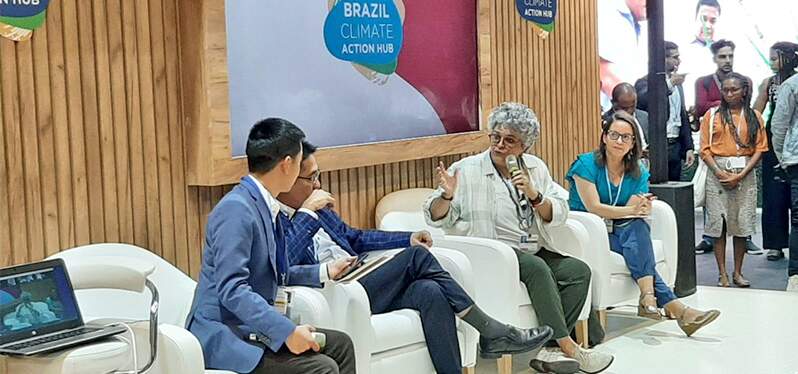
A second meeting of the day, which was quite interesting, took place at the Legal Amazon Consortium , space for the states of the Brazilian Amazon that are part of the Legal Amazon.
The highlight was the presentation of the Eastern Amazon Fund (FAO) , a fund created by the government of Pará in partnership with some private institutions, such as FUNBIO, which manages the Fund, the Instituto Clima e Sociedade (ICS) and the Gordon and Betty Moore Foundation , an American foundation that made donations. The Fund also received money from the Inter-American Development Bank (IDB). It is interesting to understand that the Fund is private, but of public interest and with a mixed governance that aims to finance projects that help fight deforestation. 3 lines are presented: combating deforestation , sustainable territories andland regularization , with great participation of traditional communities, riverside quilombolas and indigenous people.
It is important to point out that companies like Synergia are very well positioned and can contribute with this type of fund in the implementation of projects, because they need local partners . The Moore Foundation, for example, has just announced more than $300 million for a Phase 2 of this fund, which is now entering a phase of receiving proposals for implementation .
The last event, also held at the Brasil Climate Action Hub , was about the Judiciary and climate change , and had the participation of minister Luís Roberto Barroso and elected deputy Sonia Guajajara . Barroso brought up the role of the Supreme Courts around the world in relation to the climate issue, demonstrating that this transcends political opinions and positions , which by nature are short-term.
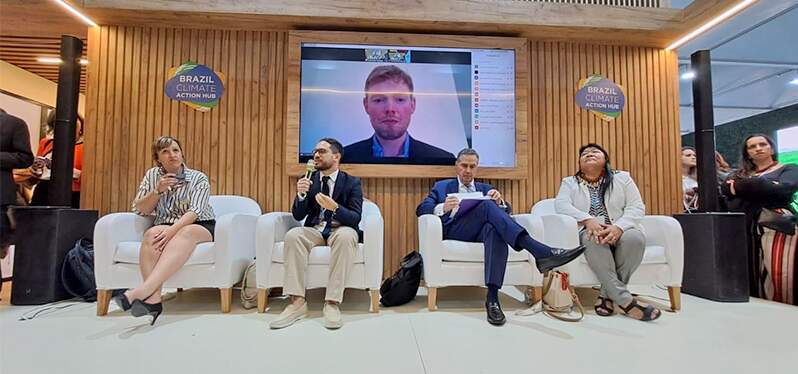
It is important to note that political cycles are short-term, politicians’ interests are short-term, but the Supreme Courts defend the constitutions , which are the great social pacts of countries and which have a long-term perspective , as well as the climate .
It was interesting that the Federal Supreme Court (STF) recognized the Paris Agreement as a Human Rights agreement in this context . This, in Brazil, has a very relevant implication , as the Human Rights legislation turns out to be even superior to national legislation , gaining a level that is not mandatory, but which, at least, marks out a series of legal understandings . The judiciary today must be not only reactive, but also a protagonist in this type of climate action.
*Bonus Interview*
Our consultant, Luiz Eduardo Rielli, had the opportunity to speak with the Rio de Janeiro City Council Climate Advisor. João Pedro Rocha , who was covering the climate justice and climate education agenda for the Chamber, told a little about his experience in these last days of the Conference . Check out the testimonial:
“From what we have seen, it is worth highlighting two main points. The first is that legislators and politicians representing Brazil have come to the COP thinking about this new cycle of public policies. They are very interested in accessing tools to replicate in Brazil, and replicate legislation, which is very important. The second point is the main discussion of this year’s event, the financing of losses and damages. How do we remedy the impacts that had already happened, unfortunately, mainly in the countries of the Global South? There are many discussions in which Brazil needs to advance. It is very important that we are following and advancing in these discussions. “
By José Alberto Gonçalves Pereira
the funding day
The fourth day of COP27 was dedicated to the thorny issue of finance , addressed in the side events of the conference and in the High-Level Ministerial Dialogue on the New Collective Quantifiable Goal on Climate Finance .
The meeting of ministers discussed the establishment of quantitative targets aligned with the scale of financing necessary to achieve the objectives of the Paris Agreement .
A reform of the Bretton Woods system was also called for , reorienting it towards a more adequate contribution from financial institutions to climate action.
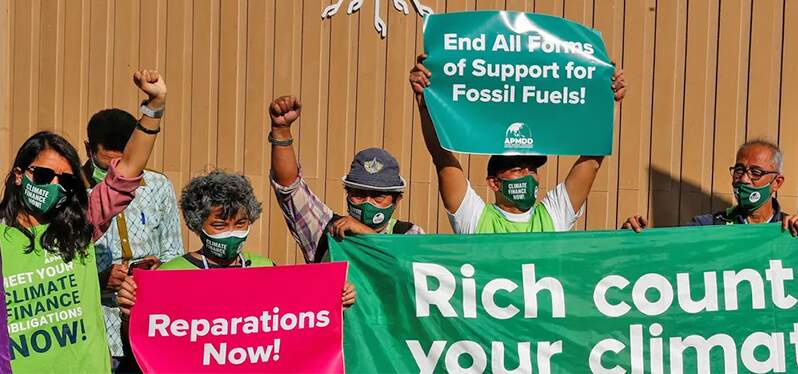
The cancellation of the debt of the poorest countries was also the object of demand by many representatives of these nations. For them, the cancellation would open up fiscal space for their governments to invest more resources in measures to reduce emissions and adapt vulnerable populations and sectors to climate change.
Two aspects stood out at the ministerial meeting:
The magnitude of the financial need is substantial and is already estimated to be in the trillions of dollars . “Governments don’t have that kind of money,” said John Kerry, the US special envoy for climate change.
Mari Pangestu, managing director of development policy and partnerships at the World Bank, stated that the institution works to mitigate real and perceived risks to investors in order to facilitate access by developing countries to private capital.
By Luiz Eduardo Rielli
The third day of COP27 , unlike other years, took place in the format of thematic round tables , seeking precisely to bring out what are the elements and ambitions necessary to ensure that, in fact, the implementation of the climate commitments already assumed takes place .
Yesterday, some thematic tables were started – always at a high level, with the presence of heads of government, heads of state and, even, ministerial-level leaders.
The first topic addressed was Food Safety . The second theme pointed out was the Just Transition , which is the analysis of the social and economic aspects of the mitigation and adaptation plans previously presented by the countries.
The third subject addressed in the round tables was finance and the search for innovations and quick ways to implement climate actions – considered the main theme of this COP.
Today, on 11/8, the COP continues the round table format. The fourth meeting was on Climate Change and Vulnerable Communities , an issue addressed under the leadership of Norway, Pakistan and Egypt.
The fifth round table was on Water Security in a context of growing impacts of climate change. Senegal and Greece took the lead in this discussion.
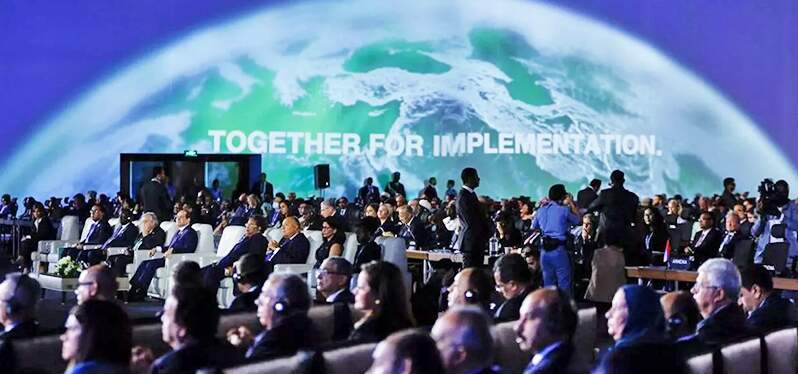
And, finally, the theme of the sixth round was about investing in the future of energy , specifically about the development of green hydrogen . The Prime Minister of Germany, Olaf Scholz, and the President of Egypt, Abdul Fatah Khalil Al-Sisi, were the leaders responsible for the debate on this issue.
These themes are now going through the responsible technicians, so that they can be defined in a more concrete way and enter the “draft”, in the draft of the final agreement of Sharm el-Sheikh.
In addition to the round tables, an adaptation agenda was also presented by Egypt, called “ Sharm el-Sheikh Adaptation Agenda ”. It addresses a set of 30 actions that must be implemented quickly to support people who will need to adapt to climate change .
It is important to reinforce that since last year’s COP, in Glasgow, the theme of adaptation has been central , because the understanding is that climate change is already occurring on a large scale , with great intensity and frequency. Therefore, it is necessary to have quick adaptation plans. This agenda focuses on, by 2030, implementing actions with a coverage of up to 4 billion people . That is, more than half of the world’s population.
Within these 5 themes, we are talking about water , natural systems , infrastructure , food security and financing . These are very important topics, in addition to adaptation, that will be included in the final draft.
Finally, today was also the opening of a specific space for debates by organizations that work with children and young people . Their voices have already been increasingly considered in the last 3 climate conferences.
In Glasgow, what drew a lot of attention was the fact that there was a great diversity of other actors actively participating in discussions and official plenaries, on the central stages. And now, we see a pavilion with a series of exhibitions and spaces for dialogues , with interactions between negotiators and organizations that give voices to children and young people.
The big change is that the UN and a number of countries have already been placing future generations as actors who need to be considered and who have acquired rights.
Portugal, for example, is a country that has recently raised the issue of future generations very clearly in its climate law . The country also innovates by applying the concept of common goods of humanity . That is, that nature and ecosystems should be guaranteed rights, as well as fundamental human rights. It is a philosophically quite evolved view, but it brings these two perspectives, these two actors: both future generations and nature itself .
Source: Sharm el-Sheikh Adaptation Agenda
By Luiz Eduardo Rielli
Yesterday we started a new cycle of climate negotiations , with the official opening led by the Secretary General of the United Nations Framework Convention on Climate Change (UNFCCC) , Simon Sitiell, inviting all parties to present their agenda proposals and define what will be discussed during COP27 .
Today, Monday, we had the political opening with the host country, Egypt, and its president, El Sissi, followed by the Secretary General of the UN, António Guterres. With that, both the technical agenda and the political agenda were formally opened and placed at the event.
The great highlight at the opening of this COP was for the presidency of Egypt , when giving voice to developing countries and island countries . The host country had already positioned itself as a representative of these less favored nations, with the aim of seeking, mainly, support measures for them – which are already suffering the consequences of climate change , are paying the bill, but which are not the origin of the problem.
These countries also do not have the conditions to deal with the consequences . A good example of this is Pakistan , a country of great territorial extension, with a very large population, but which contributes less than 1% of global emissions . However, even with very low emissions, this year it has suffered immensely from the impacts of climate change .
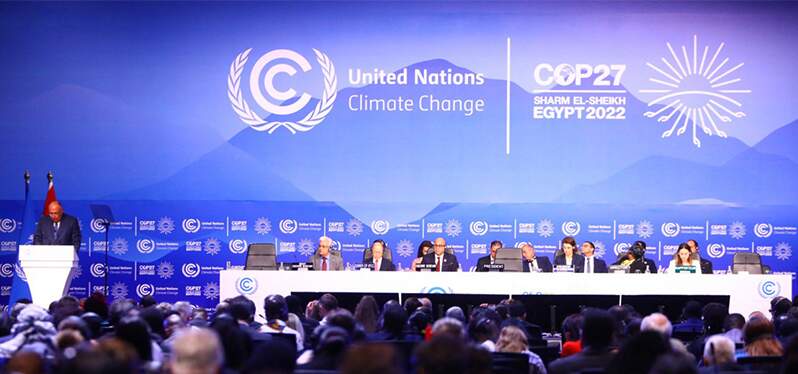
Pakistan has had major waves of rains and flooding, with 1/3 of its territory flooded and estimates of 33 million people impacted , in addition to US$30 billion in financial losses caused by this year’s rains.
How can a country responsible for only 1% of emissions have an impact of this nature, on this scale?
The cause and effect are disproportionate , and this exemplifies the request for the establishment of a “loss and damage” mechanism – the technical name given for this financial aid to developing countries .
Climate finance is key, and it has been placed centrally for the first time.
But what exactly is the “damage loss” mechanism?
They are forms of compensation . On the one hand, we have the countries that ask for it. And, on the other hand, the rich countries that, however much they recognize the importance, are always very careful not to make room for unlimited requests .
Rich countries have always tried to be very cautious and specific in defining how these resources will be given and monitored , so that they are not wasted resources and that discussions that are outside the scope of the climate are not opened.
At the Paris COP , a commitment was made to allocate US$100 billion a year to developing countries . Most of this resource should be put into adaptation. But that investment never got off the ground .
There is also an understanding, since the Glasgow Cup, that the US$100 billion a year is already completely insufficient , considering what needs to be done both for the transition and for the adaptation related to the changes that are already taking place .
Today, it is said that by 2050 , the date that is the horizon of neutralization, trillions of dollars will be needed for humanity to be able to make this transition.
In Glasgow last year, more specifically, there was a financial commitment to invest US$40 billion a year by 2025 , reaching US$300 billion by 2030 . That is, gradually increasing the required resource.
What the UN has been putting forward, and what Guterres reinforced in the opening, was a new call . A moral call for countries to make a pact for climate solidarity , specifically calling on the United States and China – actors without whom it is not possible to reach a climate solution.
Guterres called for wars , among other problems that exist in the world, not to be distractions , and called for development banks, international development agencies and cooperation agencies to make a quick change so that the climate issue is central in its large-scale financing .
This factor can have major implications for the private sector and for the market that works with the financial sector to ensure the effectiveness of these investments. Thus, all those actors who work with impact measurement, verification and monitoring, project implementation, audits and assurance – all areas necessary to ensure that Greenwashing does not occur and that these values are actually destined for projects that reduce emissions – will be primordial.
The private sector, and companies like Synergia , will have opportunities to contribute to this great challenge.
Sources:
The 27th UN Conference of the Parties arrives bringing expectations about the negotiations that can help to ensure the containment of climate change .
The interference of the geopolitical scenario in the development of global actions in favor of tackling climate change must be one of the impact factors, affecting the results of negotiations and agreements , making it difficult for commitments to be assumed and implemented.
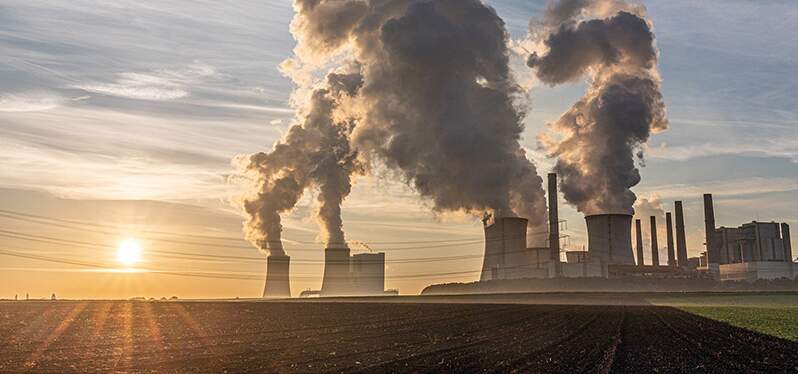
Do you want to understand the main points that can help or hinder negotiations during COP27? So, check out the article produced by Luiz Eduardo Rielli: Climate negotiations: what to expect from COP27?

Specialist in sustainability strategies and international development, with experience in infrastructure and energy markets in Europe, Latin America and Africa. He led the sustainability area at AES Brasil and Instituto AES, as executive director. He held executive positions at CPFL Energia and InterCement and was a director at Fundación Loma Negra, in Argentina. MSc in Ecological Economics, from the University of Edinburgh, United Kingdom, Bachelor in Business Administration from Fundação Getúlio Vargas (FGV/EAESP) and in International Relations from USP. He is a partner at consulting firm NOVí and a sustainability consultant at Synergia Socioambiental.
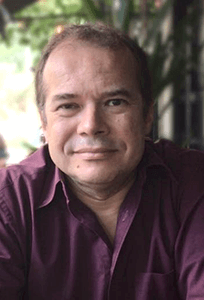
Consultant for climate change at Synergia, for more than two decades he has been researching, writing, editing and technically reviewing publications on the environment, climate and green economy for the media, consultancies and NGOs, such as WWF-Brasil and Instituto Clima e Sociedade (iCS ). He worked on the climate change team at the São Paulo State Secretariat for the Environment (SMA-SP), coordinated communication for the World Center for Sustainable Development (Centro RIO+/PNUD) and created the Climate & Economy and Economy sections on Page 22 Green. From the University of São Paulo (USP), he holds a Bachelor’s Degree in Journalism and History and a Master’s Degree in Communication Sciences.